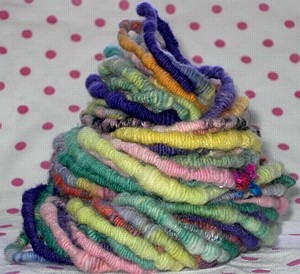 |
Spinning
coiled yarn is a simple, yet time-consuming
process where a thick and thin single is plied
and manipulated on a light weight, smooth,
strong binder; like crochet cotton, wooly
nylon (serger thread), rayon, or even embroidery
floss.
I start selecting my fibers based on what
I want the overall 'feel' of my coil to be.
I'm using both blended batts and hand painted
top.
|
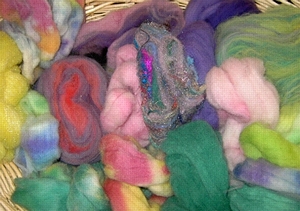 |
Don't be
afraid to 'break some rules' when selecting
your colors and fibers. (chances are if
you have read this far, you aren't afraid
anyway...)
I'm using fibers including
alpaca, hemp, nylon, mohair and wool. And
color schemes like pink with black and orange
with purple. Yes! All in the same hank of
yarn!
|
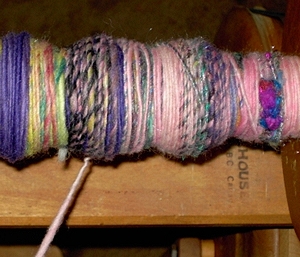 |
When
I am making this thick and thin single,
I spin it at a higher TPI (adding more twist)
than I normally would; as the coiling process
is far more intense than balanced plying
and causes the slubs/thicker bits (the parts
of the yarn that require less twist) to
become undone. I also like to add in some
very very thin bits which helps the coil
adhere to the binder thread.
When I've decided my single is finished,
I like to wind it into a center pull ball.
Keep in mind that it takes
roughly 75-100 yards of yarn to make 10
yards of coils, depending on how thick or
thin your singles are, and how tight you
get your coils.
|
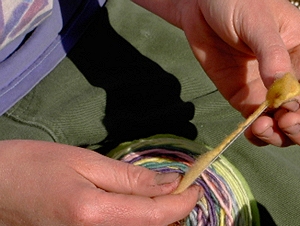 |
Time
to coil!
I like to tie my single onto my binder.
Here, I'm using a crochet
cotton. You can use anything strong and
smooth.
Then, I insert that knot between the two
plys of my leader yarn. (if you aren't using
a handspun leader you might not be able
to do this, but you can tie it right onto
you leader) |
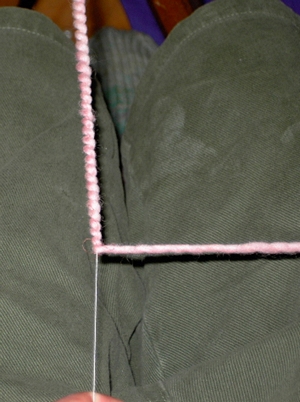 |
To create
this coil effect, I hold my single at a 90
degree angle and let it ply tightly around
my binder. |
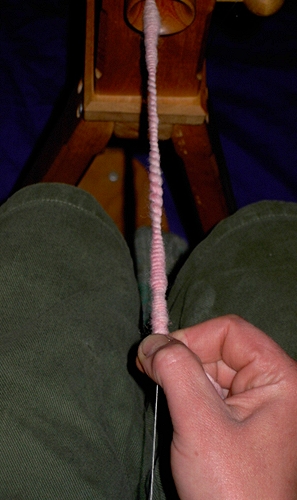 |
Taking
the section of ply that I just made, I slip
it up the binder to increase its density.
|
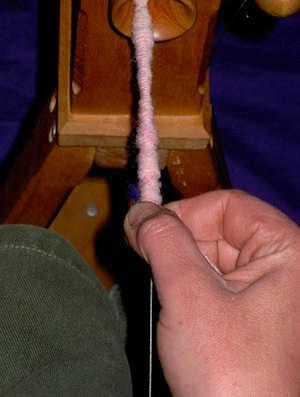 |
Holding
the binder very taut, I push some more.
|
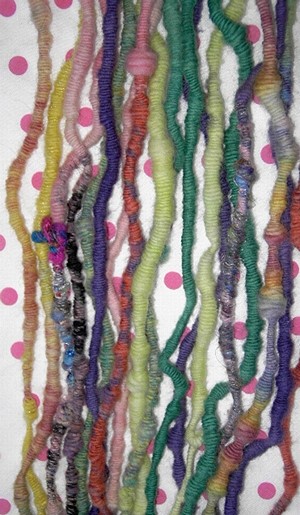 After
that it is essentially wash rinse repeat. (or
ply, ply, ply, ply; push, push.) After
that it is essentially wash rinse repeat. (or
ply, ply, ply, ply; push, push.)
A lot of people inquire as to the balance of a
coil. The traditional rules of balance are pretty
much out the window with this type of yarn. Since
the yarn ideally is plied on (or coiled) at a
90 degree angle. Therefore, the spots of in balance
may occur when the yarn is coiled at an obtuse
angle. (or where spots of "Knopping"
happen.)
|

